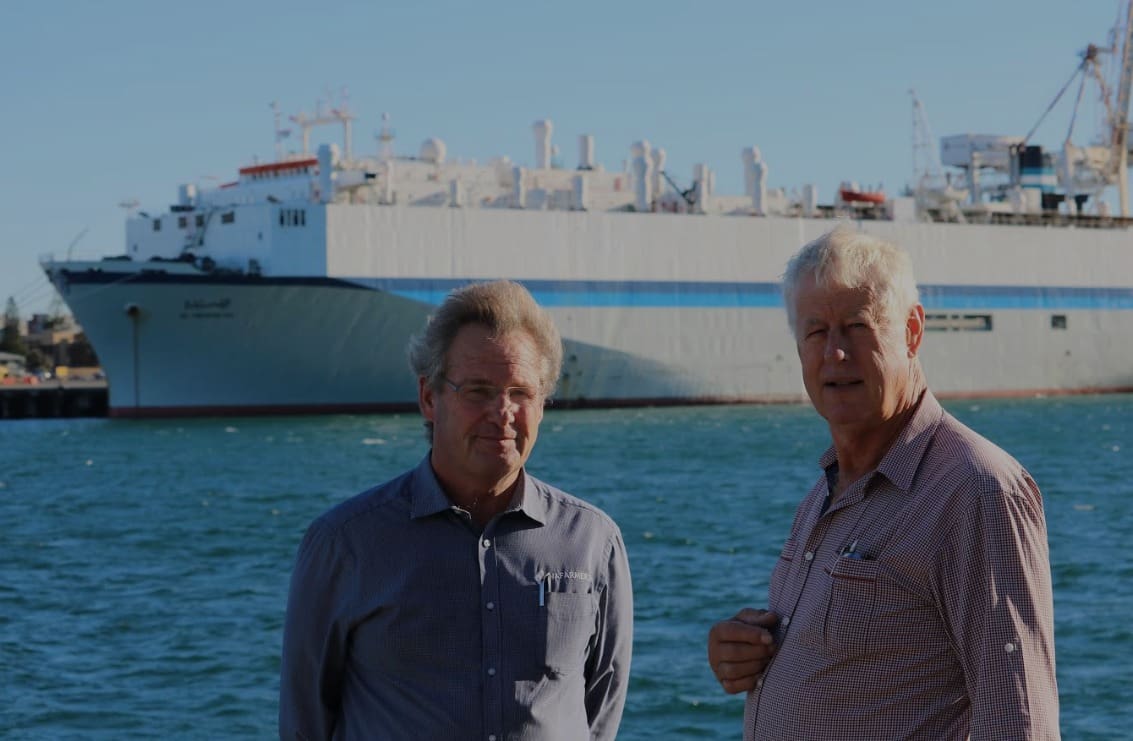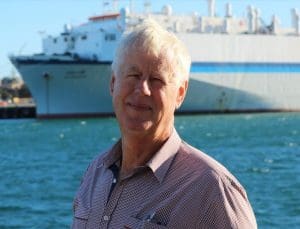
WAFarmers president Tony York, left, with PGA president Tony Seabrook.
WESTERN Australian sheep farmers hope new stock density and ship ventilation changes, and expected standard changes will negate the need to impose stricter heat stress risk assessment rules on Middle East shipments.
Exporters believe the trade could become unviable if draft recommendations from an independent Heat Stress Risk Assessment Technical Reference Panel released yesterday are adopted.
WAFarmers president Tony York said the body’s “best hope” is that data from successful 2018 sheep shipments to the Middle East might help negate the need to enforce a heat stress threshold model using a wet bulb temperature of 28°Celsius.
But Pastoralists and Graziers Association president Tony Seabrook said if the Department of Agriculture and Water Resources sets and enforces the panel’s recommended wet bulb temperature level and it becomes a finable offence “the exporters will just walk away.”
“There is no way in the world this industry can sustain itself with a six-month shipping window.”
Mr York said he hoped data on the supposed improved ability of newly configured vessels to handle heat stress will be brought forward to influence the panel’s final report, due early next year after a consultation period ending on 31 January.
“We are going to pitch that we want the standards that are adequate to protect the animals, but still give the maximum amount of opportunity to keep the trade going for longer periods of time.”
The HSRA panel has recommended that wet bulb temperature be used as a measure of a ship’s thermal environment to set a heat stress threshold for sheep. It has suggested a WBT welfare limit for a standardised shipper sheep (56 kg adult Merino wether, body condition score 3, zone 3, winter acclimatised, recently shorn) is 28°Celsius.
The panel’s report also recommended that there be a 98 percent probability that the deck temperatures the sheep would be exposed to during a planned voyage would remain below the WBT welfare limit.
A DAWR briefing paper said that a comparison with analysis undertaken during the McCarthy review suggested live Merino sheep exports from Australia during the hottest months of the year in the northern hemisphere (May to October) may not meet the WBT animal welfare criterion.
The department has suggested that under the proposed HSRA recommendations it may not be economic to export live sheep to the Middle East during the northern summer, “leading to a cessation of trade during this period,” and vessels could also carry less sheep or depending on shipboard ventilation, make fewer voyages in other months of the year.
A six-month trade is unsustainable — PGA

PGA president Tony Seabrook
However, Mr Seabrook said some of the information on which the panel had based its recommendations was “fairly old.”
“I think we now need to consider the impact of higher standards of ventilation, and most of all, the lower stocking densities, might have.
“If we are not careful, we will kill the industry by regulation,” he said.
Mr Seabrook said feedlot staff, transport operators and pellet manufacturers would not be sustained by a live sheep export trade operating only six months of the year.
“So the impact of enforcing that level of compliance will basically be the end of the live sheep trade as we know it.
“We understand that mortality ought not to be the measure, but there is a point at which you will create so much regulation at so much cost….”
Mr Seabrook said he was disappointed with recent remarks from the Minister for Agriculture David Littleproud, who said the sheep export industry and ship owners must now commit to investment in better technology to keep the industry sustainable. He said ship companies need to invest in new technologies to dehumidify their boats.
“Exporters have significantly gained financially in the past from this industry and it’s now imperative they re-invest back into their industry immediately.
“I therefore expect the industry to start to show some leadership in greater investment in animal welfare standards,” the minister said.
Disappointment with Littleproud comments – Seabrook
Mr Seabrook said Mr Littleproud’s remarks “seemed to be based on the assumption that you can do whatever you like to these live exporters and they will still be there.” The PGA leader believed exporters would seek sheep from other suppliers if the industry was shut down for longer than three months, effectively “transferring the cruelty issue to other countries who don’t give a damn.”
Mr York said WAFarmers is concerned that some of the heat stress modelling assumptions used in the report may have skewed some of the findings.
“More work now needs to be done before the industry can accept any final recommendations.
“Since April, a whole raft of new conditions has been put in place as a result of the McCarthy and Moss Reviews and these new measures have proven effective as reported by independent observer reports,” he said.
“The trade will also be implementing new standards as a result of the review into the Australian Standards for the Export of Livestock (ASEL), which will complement the welfare improvements already in place.
“WAFarmers believes these measures have proven sufficient to allow the trade to continue whilst further welfare assessments are conducted,” Mr York said.
“It is clear that the draft HSRA report suggestions will have significant impacts on, not only the live sheep trade, but will have flow on effects to other industries.
“The HSRA report is the first step in the regulatory process,” he said.
“The next step is the completion of a Risk Impact Statement (RIS) to support the final HSRA report due for release around mid-2019.
“Now that the consultation period has commenced, WAFarmers will continue to engage with the trade to analyse the outcomes of this initial HSRA report and will be providing a comprehensive response in late January,’ Mr York said.
“Our response will advocate in the best interests of WA sheep producers and the animals they produce.
“It is important to get these parameters right, as once these are ascertained, the industry can employ new technologies to ensure the continuation of the trade for all livestock, given the importance of multi-species shipments.”
Mr York said with the exporters self-imposed three-month moratorium (June to August) on northern summer Middle East sheep shipments and with producers supplying different types of animals, maybe some of the trade could be kept going in other months. Producers have already had about 4.5 months this year without a live sheep export market.
“The growers in Western Australia have already had a bit of a taste of how they can manage an extended period of no turn-off into the live trade.
“I think some adjustment has already been made, in terms of turn-off of stock and deciding what animals can go on the boats.”
Submissions to the HSRA technical reference panel’s draft report will be analysed to finalise its report and recommendations to the department. The aim is for new HSRA settings to be implemented in 2019 — before the next northern hemisphere summer. Stakeholders can provide their feedback to the draft report via the ‘Have Your Say’ platform at haveyoursay.agriculture.gov.au/hsra-review. Submissions to the panel will close 31 January 2019.

HAVE YOUR SAY